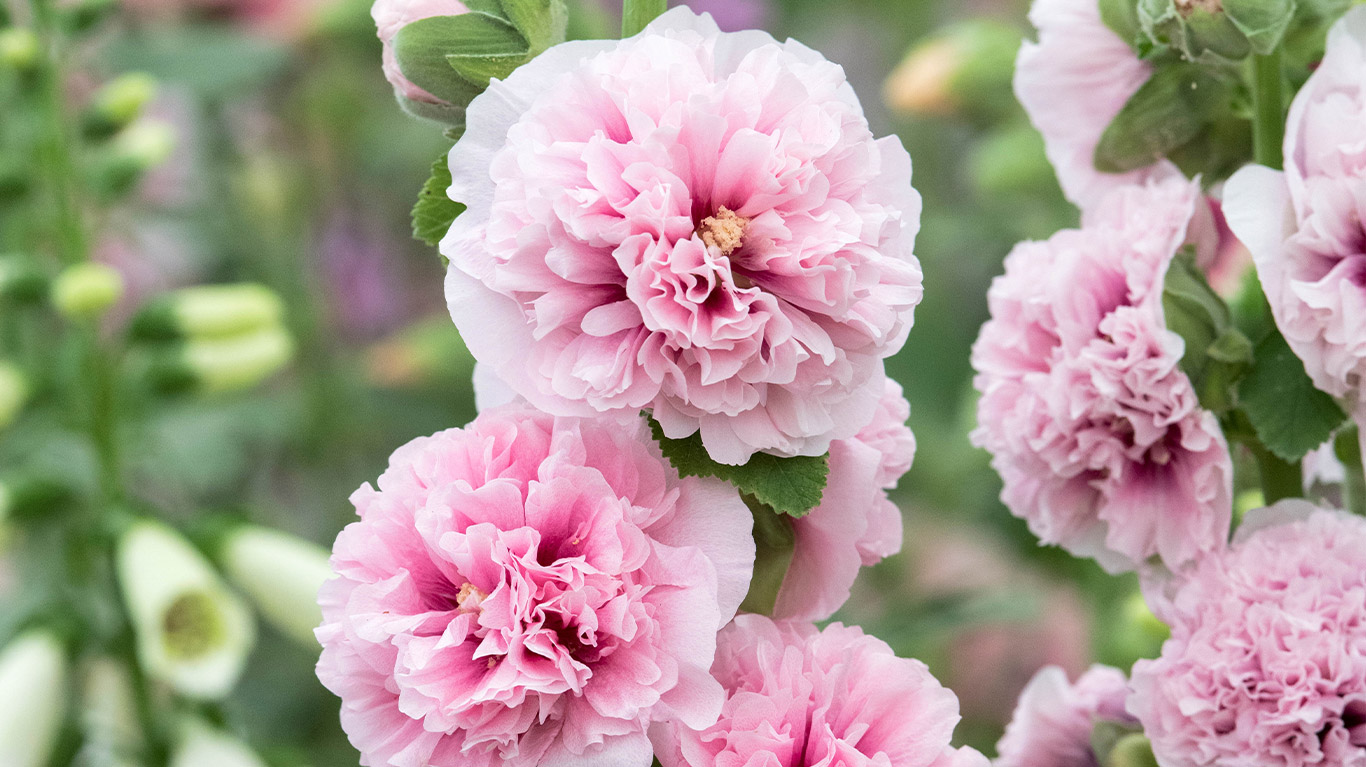
What We've Included
When to Plant | How to Plant | Where to Plant | After Care |
Common Issues | When will they flower | Inspiration
When to Plant
We sell Hollyhocks in several formats, from loose roots to pot-grown plants. You can grow loose-rooted Hollyhocks in spring or autumn, giving them plenty of time to establish themselves before summer. Thankfully, they can be planted at almost any time of year, as long as the ground is workable. Plug plants can be potted up and kept indoors before planting out, helping them establish a root system. Seeds can be sown indoors from mid or late spring, or directly outside in late spring/early summer.
How to Plant
Planting Loose Roots
Loose roots to beginners might sound intimidating but are in fact, incredibly easy to plant! Here’s how to do it.
- Soak roots in a bucket of water for 1-2 hours before planting.
- Dig a hole in the border that’s big enough to house the root system. If planting in pots, fill a large pot halfway with potting soil and then pop the roots in with the crown pointing upwards and the root system pointing to the floor.
- Plant in groups for a fuller display, usually in groups of 3, somewhere that gets plenty of sunlight.
- Ensure the crown is just below the soil unless the plant has some leaves, in which case leave them exposed with the rest of the root system under the soil.
- Water well once planted.
Planting Modules
Even easier to plant than loose roots (which is saying something!) are plug plants.
Whether you’re growing them directly outside into the border or into a container, our pot-grown plants are a breeze from the moment they arrive.
- Dig a hole in the border that’s big enough to house the entire module. If planting in pots, fill a large pot halfway with potting soil and then make several holes that can hold the modules. Do this until the top of the soil from the module is just below the top of the pot.
- Fill around the modules with soil and firm down gently.
- Water well and you’re done!
Where to Plant
Hollyhocks are naturally a sun-loving plant, basking in the rays that the season brings. Position them in areas that reach plenty of sunlight, whether that be in a sunny border or container. While you’re there, make sure to check your soil is well-drained by tilling the soil before planting, removing any large clumps of soil and stones as you go. You can further improve the soil’s drainage by adding a handful of horticultural grit to the bottom of a planting hole before you pop in your plant.

After Care
When to water
Young Hollyhocks will need regular watering. To check if the plant is feeling a bit parched, feel the soil. If it’s dry on the surface and about 15cm under, then it needs a good watering. However, older plants can be watered whenever there are bouts of dry weather.
Staking
If your garden is a bit windy, then you might want to stake your Hollyhocks as they grow. You can use a bamboo cane or stake, tying the stem to them to avoid unnecessary breakage.
What to do once they have finished blooming
Hollyhocks are completely hardy against cold weather, allowing you to leave them in place as winter takes over. Simply cut down any foliage and stems once they’ve finished flowering and discard any that may have been affected by rust (more on this later).
Deadheading
Once Hollyhocks have finished flowering, they will proceed to self-seed. This means that they will drop their seeds, allowing them to germinate and grow again the following year. If you don’t want them to do this, then cut the stems down to the base, just above the soil’s surface.
Common Issues and How to Solve Them
Rust Disease
Unfortunately, Hollyhocks can be victims of what’s known as ‘Rust Disease’. They can grow this on their own after a few years of growth, so you can discard and replace plants every 3-4 years. However, if you’re vigilant and catch it in time, or if just one plant is affected, get rid of it before it infects the rest of your display. Fungicides can be used to treat rust disease but are not encouraged by the RHS.

When will they Flower?
Hollyhocks have a long flowering period, lasting for months on end. They’re a perfect pick for gardens that need a boost of colour, particularly toward the end of the summer and into early autumn. Grow them in your Cottage Garden displays in abundance for a sublime show throughout the season.
Ready to Shop?
Find some inspiration for your garden
